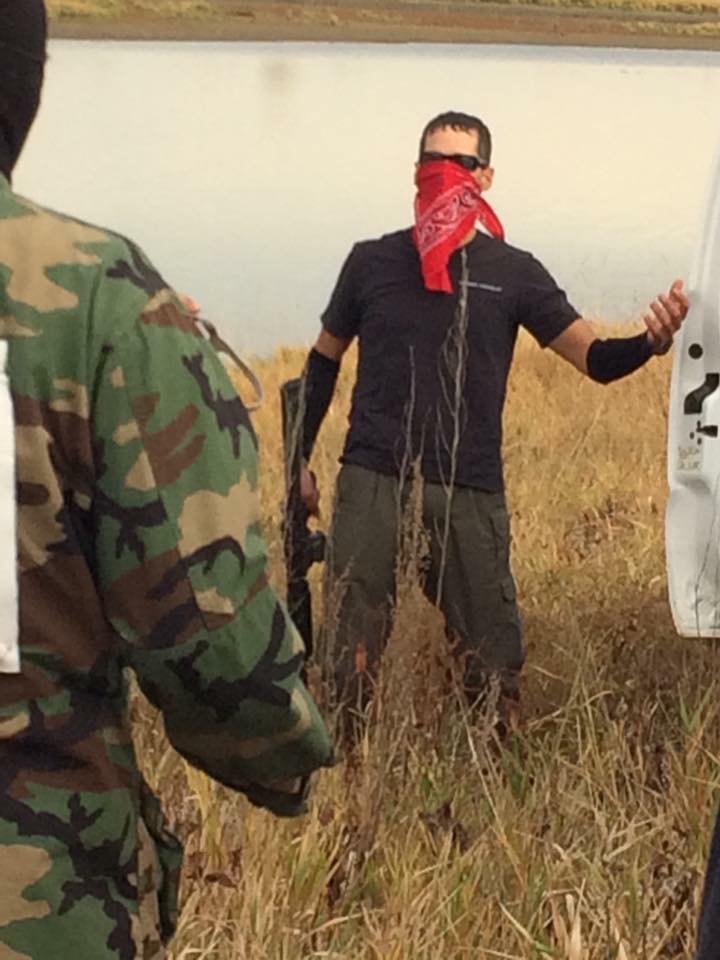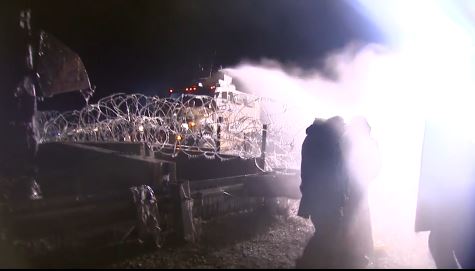(Kyle Thompson, right with weapon, confronted by a group of water protectors on Oct. 27. APTN/Photo)
Watch APTN Investigates documentary on #NoDAPL movement
Jorge Barrera
APTN National News
North Dakota authorities used Facebook posts and video to issue arrest warrants for three men to face charges in connection with a confrontation between anti-Dakota Access Pipeline (DAPL) demonstrators and an armed security contractor working for the pipeline company.
The Morton County Sherriff’s Department, which has been the lead law enforcement agency facing anti-DAPL demonstrators, known as water protectors, issued a wanted poster for the three men on Thursday.
The Sherriff’s Department also released an affidavit describing part of the investigation into the confrontation on Oct. 27 between an armed DAPL contractor and ex-U.S. soldier named Kyle Thompson and a group of water protectors.
That day saw intense clashes as North Dakota law enforcement, backed by officers from various states and the National Guard, descended on a camp along Hwy 1806 that was being used to launch rolling blockades aimed at slowing down construction of the four-state pipeline.
Thompson was run off the road by water protectors who believed he was an infiltrator. Thompson was filmed by an APTN National News crew holding an assault rifle and confronting the water protectors, who did not have guns. Thompson was eventually arrested by Bureau of Indian Affairs (BIA) agents who turned him over to the FBI. The FBI then turned Thompson over to state authorities and he was released without charges.
The North Dakota Bureau of Criminal Investigations (BCI), which is under the state’s Attorney General’s Office, took the lead on the investigation. On Nov. 23, Gabrielle Goter, assistant state’s attorney in Morton County, filed charges against Brennon Nastacio, 36, Michael Fasig, 46, and Israel Hernandez, 22, with the state court.
A warrant was also issued for their arrest.
Nastacio is facing a “terrorizing” charge for allegedly holding a knife while “walking toward” Thompson, who was armed with an assault rifle. Fasig and Hernandez both face a “reckless endangerment” charge for allegedly ramming Thompson’s truck. The two men also face a charge of “criminal mischief” over the same incident.
Investigators used Facebook posts, photos and videos to identify two of the three men and support the charges, according to an affidavit filed by Scott Betz, an officer from Burleigh County, North Dakota.
According to the affidavit, investigators identified Hernandez and Fasig through a photo posted on the Iktce Wichasa Oyate Facebook page where both men posed with their vehicles, a silver coloured pickup truck and a maroon Cadillac SUV. The affidavit notes the caption posted with the photo which reads: “Two of our Iktce Wichasa Oyate warriors, and their war ponies, injured while stopping an armed DAPL worker’s vehicle.”
Investigators identified the two men in the photo as Hernandez and Fasig.

Iktce Wichasa Oyata describes itself as a sub-camp of the Oceti Sakowin Camp, which is the central nervous system of the Native American-led anti-DAPL movement. The Oceti Sakowin Camp sits on the edge of the Standing Rock Sioux reservation.
Investigators compiled several posts Fasig made on his personal Facebook page where he allegedly mentions ramming Thompson’s truck and damaging his own vehicle.
“My war pony took a injury yesterday [sic],” said one Fasig post on Oct. 28.
“Dapl mercenary being arrested after he made a high sped attempt to reach main camp with a AR-15, my truck suffered some damage, I chased him and was forced to ram him [sic],” said another Fasig post, on Oct. 27, described in the affidavit.
Authorities also reviewed a video posted to Facebook on Oct. 29 where Fasig allegedly describes the incident.
“Mike Fasig said that he got a ‘call’ on the radio about a white pickup truck with an individual who is armed travelling at a high rate of speed and don’t let him get to the camp,” said the affidavit, describing the alleged statements on the video.
The affidavit stated Fasig said in the video a “young male” driving a “Cadillac” from “New York” had “nailed” Thompson’s “DAPL vehicle twice.”
The affidavit stated Hernandez admitted his involvement in the incident to a BIA agent on Nov. 17. The BIA agent stated Hernandez said he was in the Cadillac with Fasig’s son Derrick, according to the affidavit.
The Cadillac, which was owned by Hernandez, was impounded by BIA and held in Fort Yates, the main community on the Standing Rock reservation. Betz said he travelled to Fort Yates to inspect the vehicle.
The affidavit does not say how authorities managed to identify Nastacio or confirm he was carrying a knife. The document states Thompson claimed “a male wearing a fur hat advanced towards” him with a “buck knife” during the incident.
“The individual wearing the fur hat was identified as Brennon Nastacio,” said the affidavit.
During the incident, Thompson was driving a truck owned by Dakota Access LLC, the company behind the controversial Dakota Access Pipeline project. Identification and documents taken from the truck indicate Thompson was a security contractor for the company. The documents showed Knightsbridge Risk Management, a private security firm with a Springfield, Oh., address, was insured to the operate the truck.
After the company truck was rammed, Thompson was photographed carrying and assault rifle and wearing a red kerchief over his face.

The Standing Rock Sioux Tribe issued a statement shortly after the Oct. 27 incident alleging Thompson fired shots from the rifle and that he was disguised as a water protector.
A BIA spokesperson said agents responded to the incident following reports of shots fired.
In a Facebook post, Thompson denied firing shots and stated he was simply at the scene to inspect company equipment which had been damaged during events that day. He claimed someone fired a flare gun at him.
The law enforcement sweep on Oct. 27 pushed the water protectors south down Hwy 1806 and across the Backwater Bridge to the Oceti Sakowin Camp. State authorities then set up a barricade with concertina razor wire and concrete barricades backed by Humvees and armoured personnel carriers just north of the bridge. This was the spot from where authorities hammered water protectors with a water cannon, tear gas and rubber bullets from the evening of Nov. 20 into the early morning hours of Nov. 21. Hundreds of people were injured as a result of the onslaught. One woman, Sophia Wilanksy, 21, is currently still in hospital where she faces months of surgery to save one of her arms which she said was hit by a projectile fired by police.

The Morton County Sheriff’s Department claimed the woman was injured as a result of a premature detonation of a small propane canister rigged as an explosive device.
The FBI is investigating the incident and obtained Wilanksy’s clothes, after her family consented.
The Oceti Sakowin Camp sits on land just across the border from the Standing Rock reservation. It is identified by authorities as U.S. Army Corp of Engineers land leased for grazing. The land is also part of Sioux treaty territory.
The Army Corps has issued an eviction order to the camp which comes into force on Dec. 5. The Army Corps has said it does not want to forcibly evict people from the camp which has a fluctuating population that ranges from the low thousands to the tens of thousands.

All sides are also awaiting a decision from the Army Corp on whether to grant Houston-based Energy Transfer Partners, the parent company of Dakota Access LLC, an easement to run the pipeline under Lake Oahe, a reservoir on the Missouri River.
The Dakota Access pipeline has been built to the edge of the lake and the construction site is protected by recently erected walls. The company is allowed to drill about 60 metres down into the ground by the water, but can’t drill horizontally until the Army Corps grants the easement.
This is the believed to be the last step of a review of the project which was announced in September by the administration of U.S. President Barack Obama after Standing Rock failed to obtain an injunction against pipeline construction with the U.S. Federal Court.
The Army Corps of Engineers only has jurisdiction over the pipeline’s path directly adjacent to and under Lake Oahe.
Standing Rock and Cheyenne River say the oil pipeline threatens the area’s water supply.
The proposed 1,886 kilometre pipeline is slated to pump about 500,000 barrels of oil per day from the Bakken shale fields in North Dakota, through South Dakota and Iowa to Illinois.
The pipeline traverses Standing Rock’s treaty territory established through the signing of the Treaty of Fort Laramie in the 1800s.
@JorgeBarrera










